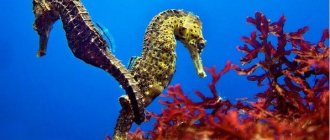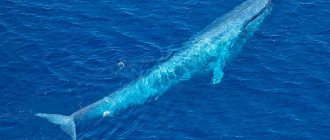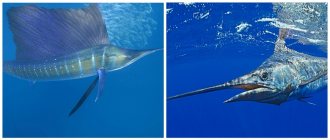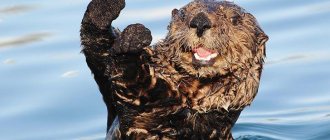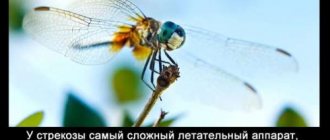What do you know about acne? You will probably answer that they look like snakes and are a delicacy. However, not everything is so simple – exciting discoveries await those who want to get to know each other better. They can travel overland, even up to several kilometers. There is also a certain stage in their life - spawning, which leads to the death of the individual. In this article we will look at the most interesting and mysterious facts from the life of these amazing creatures.
| Class | Ray-finned fish |
| Squad | Eels |
| Family | Acne |
| Genus | Acne |
| View | River, Sea |
| Security status | Threatened |
| The average size | Up to 2 meters in length, up to 4 kg |
| Lifespan | Up to 85 years old. The famous record-breaking eel lived 155 years. |
| What does it eat? | Insect larvae, mollusks, frogs, small fish |
| Optimal feeding time | Mostly at night, sometimes during the day |
| Enemies | During the passage of the Gulf Stream, they are numerous. |
| What do they bite on? | Worm, small doubles. |
A little history
Development began more than 50 million years ago. At the same time, there was a division into 4 genera, 20 families, 111 species and about 800 subspecies. Like all underwater inhabitants, they are grouped into different scientific classifications. One of the most common species is a subspecies called Anguilliformes (river Anguillaanguilla species).
These radiant fish are classified as bony vertebrates. They include all the popular families such as moray, spaghetti, American, European and others.
Photo of river eel:
They spawn and migrate to fresh water. This movement is temporary - they remain marine in nature and require salinity. At maturity they return to the ocean to breed.
Salinity is essential for healthy individuals. Therefore, there are no real freshwater families in nature.
The name is also used to refer to other types such as electrophorus, spiny (family Mastacembelidae) and deep-sea slant-headed (family Łauraczowate). However, other genetically related individuals have developed an elliptical body shape during evolution, and this is their main difference.
More than 100 kilograms of eels detained in Hong Kong, Spain
Image of a fish
It is extremely difficult to say what an eel fish looks like, since taking a photo of an eel fish is not easy, since in principle it cannot be caught with simple gear, and even the greatest trickster cannot catch it in his hands. The reason for this is his uncomfortable body. The eel wriggles like a snake, crawling across land over short distances.
Some people enthusiastically interpreted that the river eel fish is different from others in that it can crawl from one end of the river to another if there is a small distance of land.
Emergence
The main habitat is the lakes of Western and Central Europe, as well as the southeastern and central Atlantic Ocean and all European seas. Representatives prefer warm and heavily vegetated places with a muddy bottom, although it can also be found in fast rivers with a rocky bottom, especially if it finds eroded banks, tree roots and other shelters there. He lives at the bottom. He spends the winter buried in a mule.
Eel habitats
Until they reach sexual maturity, they live in inland waters - females inland, males in the brackish water range. Adults migrate from fresh water to the sea (catadromous migration).
Market Trends
European aquaculture is now quite mature. The industry will undergo minor changes in the near future, including the construction of new production units. There is an acute shortage of planting material and restrictions on catching juveniles from their natural habitat.
Research and efforts to improve the efficiency of European eel culture should include the following steps: 1. Increasing the sustainability of wild eel populations; 2. Artificial production of larvae to create a sustainable, self-sufficient culture; 3. Improved cultural systems and production automation, as well as improved management; 4. Control and prevention of the development of infections; 5. Consolidation of markets and creation of new markets; 6. Training of technical personnel involved in eel farming.
physical characteristics
Freshwater representatives are very similar to snakes, but this is only a superficial resemblance. Their exterior is amazing. The bodies are covered with a thick layer of mucus. They lack pelvic ribs, and many species also lack pectoral fins. The dorsal and anal fins are connected to the caudal fin, forming a single stripe running along a large part of the body.
The female reaches up to 200 cm in length and weighs up to 9 kg.
Males are smaller than females and reach a length of up to 60 cm (the so-called lace) and a weight of up to 0.35 kg.
The general characteristics are as follows:
- The body is elongated, 5 cm long. Depending on the species, they can grow from 1.2 to 4 m in length. The length of the record individual was 6 meters, and its weight was 72 kg.
- Adults weigh from 1.1 kg to over 25 kg.
- They usually have pointed heads with sharp teeth. Individuals that live deep in the sea are usually gray or black. Individuals that live in tropical areas have bright patterns and colors.
- They swim by generating body waves that travel along the length of their bodies. They can flow backward, inverting the direction of the wave.
Depending on the environment in which they live, their bodies acquire a lighter or darker color. Some individuals can be almost black, while others have an olive tint. In addition, the shape and size of the snout depend on the ecosystem in which the fish is found. First of all, it depends on food.
And therefore, individuals with a narrow head are found where they have the opportunity to feed on small crustaceans, larvae and worms. In places where fish and larger amphibians predominate, it adapts its mouth to this type of food, due to which the muzzle becomes many times wider.
The appearance of the larvae was so different from the adults that for a long time the leptocephala (as it is technically called) was considered a separate group. The larvae have a smooth, transparent, highly flattened lateral and elongated body with micro internal organs. They are also an exception among vertebrates because they have no red blood cells or hemoglobin in their blood.
Economic importance
Minor. It is extremely rarely caught in the Black Sea. It is caught mainly by trawls. Conger eel meat is less valuable than river eel meat; it is fibrous and contains less fat. Sea eel is consumed fresh, salted and smoked. Just like other eels, the blood and mucus of the conger eel contain harmful substances, so during processing this fish must be bled and washed.
Literature: 1. Lebedev V.D., Spanovskaya V.D., Savvaitova K.A., Sokolov L.I., Tsepkin E.A. Pisces of the USSR. Moscow, Mysl, 1969 2. K. Kukhorenko, Y. Komarov. Commercial fish of the eastern tropical Atlantic. Kaliningrad book publishing house, 1966 3. Commercial fish of Russia. In two volumes / ed. O.F.Gritsenko, A.N.Kotlyar and B.N.Kotenev. - M.: VNIRO publishing house. 2006.- 1280 p. (Vol. 1 - 656 pp.). 4. Vasilyeva E.D. Nature of Russia: animal life. Fish. - M.: LLC "Firm Publishing House ACT", 1999. - 640 p. 5. Methodological materials for identifying deep-sea bottom fish in the open part of the North Atlantic. - Murmansk: PINRO, 1986. - 222 p. 6. Wheeler A. Key to fish in marine and fresh waters of the North European Basin. Per. from English Preface and comment. V. P. Serebryakova. - M.: Light and food industry, 1982. - 432 p., ill. 7. Fauna of Ukraine. In 40 volumes. T.8. Fish. Vol. 3. Loach, catfish, ictaluridae, freshwater eels, conger, garfish, cod, stickleback, needlefish, gambusiaceae, zeusaceae, sphyrenes, mullet, silverside, bugs / Movchan Yu.V. - Kyiv: Nauk, Dumka, 1988. - 368 p.
The most common marine species
Some of the most common species are sea eels and moray eels. They live only in salty oceans and seas. There are over 100 different types and they are primarily found around the Atlantic coasts of North America and Europe. Congeras can be up to 1.8 m long and weigh more than 45 kg. They prefer to live in deep water and are blackish or grayish in color.
Photo of conger eel:
Moray eels are the most popular species in the world. They live in tropical seas, in shallow waters and can be found in crevices among rocks or coral reefs. They are predators. When they are not hunting, they hide in rock crevices or, in the case of some individuals, in burrows, sand or mud.
They have bright colors and skin patterns. They are about 1.5 m long, with the exception of one species that reaches 3.5 m in length.
Growing technique
Extensive pond system
The traditional form of eel cultivation in Europe is cultivation in ponds with an area of 100-350 m2. After reaching marketable size, the eels are moved to larger ponds with an area of 1000-1500 m2. Reservoirs can have still water or flowing water. The temperature in the ponds varies from 18 to 25 °C.
Intensive cultivation in RAS
Recirculating water systems include cylindrical pools of 25-100 m2, which are usually constructed of cement or fiberglass. Eels are placed in them with a body weight of 50 grams. Planting density reaches 100-150 kg/m2. Extruded dry food (1.5-3 mm) is automatically added to the container several times a day. The growth rate of individual fish varies greatly, so grading is carried out every 6 weeks to optimize fish growth.
Valliculture
Extensive cultivation of eels is also carried out in sea and brackish waters in the form of valliculture. In these Mediterranean systems, for example in Italy, juveniles are stocked at a body weight of 15-35 grams and a stocking density of 4-15 kg/ha. Juveniles are mainly imported from France, but also Denmark, the Netherlands and Sweden.
Life style
Most species are nocturnal, so they are rare. Sometimes they are seen living together in holes or "bottoms". Some also live in deeper waters on the continental shelf and on deep slopes up to 4000 m. Only members of the Anguilla live regularly in fresh water, but also return to the sea to breed.
It usually lives in water, but during the migration period it can also move on land, crawling at a speed of about 3 km/h on wet soil covered with grass and mosses. Diffusion of gases through the skin is of great importance during breathing. This is a long-lived fish - up to 85 years.
What does an eel like?
For food, the eel likes to eat frogs, snails, small fish, fish eggs, worms, newts and mollusks. Most eels live in reservoirs filled with tench and pike. This is their favorite delicacy. After a long life in a body of water, the eel has acquired the skills of ambush hunting.
Interesting materials:
How to open Sims 4 in full screen? How to open the remote desktop in full screen? How to open a tab in full screen? How to open the game in full screen? How to open a second screen? How to go full screen on keyboard? How to move the language bar to the bottom of the screen? How to move the time on the Honor lock screen? How to flip the screen on an Apple tablet? How to flip the screen on Samsung A 51?
Habitats
Some families live in places with fresh water, such as ponds, rivers and lakes. When they are ready to breed, they travel or migrate to the salty waters of oceans and seas. However, many eels always live in salt water. Eels are found throughout the world.
In the spring they enter our ponds from the Baltic Sea and settle in river systems and lakes, where they usually live for six to ten years. They are bottom dwellers, meaning they are usually found on the muddy or sandy bottom of a body of water.
Another feature is the ability to sense temperature changes as low as 0.03°C.
How to choose and how to store
In order for fish to be tasty and healthy, it should be chosen correctly. You should definitely appreciate the smell of eel. It should not have a characteristic fishy aroma. Next, the eel's skin is examined. It should be smooth and shiny.
You can also determine the freshness of fish by the eyes. If they are clear, then the fish is most likely fresh. According to another test, you need to press on the carcass with your finger. In a low-quality specimen, the pit remains for a long time.
It is advisable to use fresh fish as soon as possible. You can keep the fish on the bottom shelf of the refrigerator for several hours. Only cut fish is stored in the freezer. The approximate shelf life of the product is 2 months.
Smoked eels
Reproduction
Reproduction in captivity is impossible. It should be remembered that this fish lives in European rivers, lakes and ponds only at the juvenile stage. When individuals reach sexual maturity (from 6 to 12 years for males and from 9 to 18 years for females), they return to their place of birth: in the Sargasso Sea, to the Atlantic Ocean off the coast of Florida (USA), where they breed and where they come from do not return.
The larvae remain there for up to two years and then migrate to European shores. Their journey lasts from 200 to 300 days. Eels arrive in southern Europe at the beginning of winter, and regions further north reach later, until early next summer. They develop into shapes called glass or river eels.
These are small transparent fish ranging in size from 6 to 12 cm. They remain in the mouths of rivers, where they feed on plankton. Then they gradually colonize rivers, lakes and ponds in lowland areas, where they transform into yellow eels.
Most migratory fish, such as salmon, are anadromous - spawning in fresh water and spawning as adults in salt water. Meanwhile, the species in question does the opposite: it breeds in the ocean and spends its adult life in lakes, rivers and estuaries. Life according to this scheme is called catadromic.
Female eels are found in the upper reaches of rivers, while males remain near the mouth. These fish can spend up to 20 years in inland waters before returning to the ocean to spawn, after which they die. No one has ever observed this process.
For biologists dealing with this, solving the species' reproduction puzzle is something of a Holy Grail.
Planting material
Glass eels are caught on the coasts of France, Portugal, Spain and Great Britain, and then used within the country or exported to other countries. Some fishermen use nets and trawls to catch eels. In the UK, the only legal method of catching is a net.
Initially, small glass eels (0.33 g each) are kept in small quarantine aquariums with an area of 3-4 m2. Planting density is 10-15 kg/m2. Acne is examined for infection and treated if found. In addition, the juveniles are accustomed to an artificial diet with the addition of cod roe, and later to dry food. When eels reach a weight of 5 grams, they are moved to nursery containers (6-8 m2) at a stocking density of 50-75 kg/m2. At this stage they are already consuming dry granular feed (1 mm).
European eel culture cycle
Competent fishing
Eels can be found in almost every larger body of water, but they are not an easy catch. With the right equipment, determination and knowledge of habits, it is possible to catch one with a hook.
When searching for a place, special attention should be paid to the type of bottom and the amount of food. Fish don't like noise, so secluded bays with lots of plants are the place to find them. In rivers, it can be found at the mouths near calmer waters in close proximity to spurs and other obstacles. It feeds mainly at night, so this is the best time for fishing.
How to install fishing rods
Groundbaits
A highly developed sense of smell is the main advantage of the species. Attractive aromatic bait attracts them even from a very long distance.
A good bait is sand and silt balls mined from the shore in combination with crushed fish, earthworms, snails and other invertebrates. The most popular baits are red or white earthworms and fish pieces.
.Sea fishing .Tackle “SNIZH-CHUGH”
Equipment
It is almost impossible to catch with bare hands. It is covered in thick mucus and slithers like a snake. Since fish are most often found in the lower zone, anglers usually use the land-based method. Success will be guaranteed by a good, durable fishing rod equipped with a special set:
- reel - preferably a spinning reel, with a large amount of wound line (0.3 mm);
- hook with eye No. 6 or 4; the hooks used to catch these fish are 1/0, 2/0, 4/0, depending on the bait used;
- leading - from 70 cm to 1 m, made of thinner monofilament (0.25 mm);
- ground weight - in the form of olives or tears 20-30 g (maybe weight with anti-ball tube);
- swivel - located between the main line and the leader.
Since underwater fishing often traps specimens in underwater roots, it is not recommended to use side weights or bait baskets.
If we use the float method, the best would be 25mm fishing line, 0.20mm line up to 0.5m long, No. 6 eye hook, weights, depending on the float offset, 3-4 meter fishing rod. When fishing with a float, we need to place the bait just above the bottom or above the vegetation.
A well-chosen location, a favorable aura, patience and well-prepared equipment will guarantee a catch.
Eel fishing
After the ice melts, when night frosts are a rare exception, targeted eel fishing becomes possible. When choosing a place for fishing, you should give preference to areas with a soft bottom, in which it is easy for the eel to make a hole. The fish feeds in bottom thickets and ambushes behind existing obstacles. After the water warms up above 15 degrees at night, it can be found everywhere: in depth, shallow water and on the current. In the warm season, a good sign of the presence of eels is coastal vegetation hanging over the water.
Use in cooking
Eel is present in the culinary traditions of all European countries. It is eaten in many ways and there are countless recipes to prepare it. It is sold fresh or processed (smoked, pickled, boiled, sliced, filleted, canned or frozen).
It has tasty, fatty, white, tender meat with few bones, rich in omega-3 acids, highly digestible protein, vitamins A, B1 and B2, vitamins C and E, as well as minerals: calcium, iron, phosphorus, potassium and sodium.
Its useful value is really high - it is 75%!
This is a real delicacy on our tables, it tastes great in a stuffed or fried version, and also - with a lot of fat - smoked, grilled or deep-fried.
This heat treatment of meat gives it a juicy taste, durability and amazing aroma. Sensational flavors with the addition of Provençal herbs, lemon juice or dill.
Sale
Eels are sold in two forms after smoking: 120-180 grams is the normal size of smoked eel in Denmark, or 300-600 grams in Germany (large smoked fish). A small number of individuals are sold in fried, jellied or stewed forms. A more specific product called Kabayaki comes from Japan. Its preparation involves gutting 150-200 grams of eel. Then the fillet is placed on a skewer and steamed or grilled under soy sauce. Approximately 90% of all Anguilla eels grown are consumed using the Kabayaki recipe.
Japanese-style European eel Kabayaki
In 2002, the key producers of eel were the Netherlands, Italy and Denmark. They were followed by Spain, Greece, Sweden, and Germany. A small share belonged to Algeria, Hungary, Macedonia and Morocco.
Cultivation of European eel in the world (tons)
